|
Chemical Complementation of
Androgen Receptor Mutations Associated with Androgen Independent
Prostate
Cancer |
Ordered
alphabetically by student's last name
| Bourreza | Hullman | Karpowicz | Kotowski | Meyers | Passarelli | Schnitker | Silverio | Thornley |
| Dignan | Jegede | Knerr | Koyoshi | Omondi | Patel, A | Shuman |
Smith, A | Zony, C |
|
Chemical Complementation of
Androgen Receptor Mutations Associated with Androgen Independent
Prostate
Cancer |
|
Adenylosuccinate
lyase (ASL) is a metabolically important enzyme that catalyzes two
distinct
reactions in the purine nucleotide biosynthesis pathway: conversion of
adenylosuccinic acid to adenosine monophosphate (AMP) and fumarate, and
conversion of succinylaminoimidazole carboxamide ribotide (SAICAR) to
aminoimidazole carboxamide ribotide (AICAR) and fumarate. Human ASL
exhibits
marked instability compared to the ASL of other species because it is
easily
oxidized and is cold-inactivated. It contains 13 cysteine residues that
are not
conserved among other species and that are presumably not involved at
the
catalytic site. Six of these residues are close enough to form unwanted
disulfide bonds upon oxidation: Cys266, Cys304,
Cys305,
Cys180, Cys172, and Cys173. It is
possible to
stabilize human ASL by keeping it in solution with reducing agents like
dithiothreitol (DTT), but this is cumbersome and often impractical. In
order to
stabilize the enzyme, serine residues were systematically substituted
for
cysteine through site-directed mutagenesis and overexpression in E. coli. A Vmax and Km
were obtained for the WT, C266S, C304S, C305S, and C180S. All of these
enzymes
had comparable values for both the Km and Vmax .
Circular
dichroism was used to compare the secondary structure of the enzymes.
The
thermostability of the mutants was tested at 60ºC and compared to
the wild type
(WT). C266S lost activity within 5 minutes, while the rest only lost
activity
over a period of hours. (Funding
provided by HHMI.)
|
 Synthesis of New Alkaline Earth and Pnicogen Compounds Jonathan E. Hullmann and Svilen Bobev Department of Chemistry and Biochemistry While
pursuing the synthesis of compounds in the Zintl phase structure type Ca11GaSb9
two new alkaline earth and pnicogen compounds, Sr4Sb3
and
Ba4Sb3, were serendipitously discovered. Previous attempts to synthesize these two
compounds using stoichiometric ratios had failed. The
use of In and Ga fluxes as a solvent to
lower the melting point of other phases allowed for the evasion of the
thermodynamically stable and exceedingly prevalent AE11Pn10
phase (AE= Ca, Sr, Ba; Pn= Sb, Bi). These
new compounds belong to the anti-Th3P4
structure type and crystallize in the space group I-43d, number 220. The crystallographic unit cell parameters
were found using single crystal X-ray diffraction to be a=9.91(1)
Å, and a=10.28(2)
Å respectively. These results were
then
confirmed by powder diffraction. Attempts
to synthesize the remaining compounds in this
series are
underway. Supported by NSF Summer Research Program in |
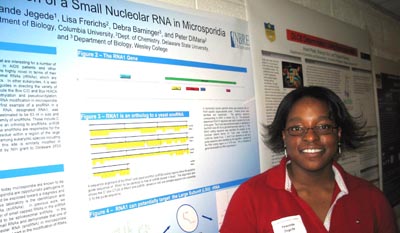 Identification of a Small Nucleolar RNA in Microsporidia Yewande Jegede1, Lisa Frerichs2, Debra Barninger3, Peter DiMaria2 1Department of Biology, <Microsporidia
are eukaryotic obligate intracellular parasites that are interesting
for a
number of reasons. Medically, they are
opportunistic pathogens in AIDS patients and other immunocompromised
individuals. These organisms also are
highly novel in terms of their molecular biology. This
includes the presence of ribosomal RNAs
(rRNAs), which are prokaryotic-like in terms of their size and other
characteristics. In other eukaryotes, it
is well established that small nucleolar RNAs (snoRNAs) act as guides
in
directing the variety of nucleotide modifications associated with rRNAs. These include the Box C/D and Box H/ACA
snoRNAs which are responsible for 2’-O-nucleoside methylation and
pseudouridylation, respectively. However,
little is known about snoRNAs and rRNA
modification in
microsporidia. In the present study, we
report the identification of the first example of a snoRNA in a
microsporidian
(Vairimorpha necatrix). The
identified RNA, designated RNA1, was characterized at both the gene and
RNA
level. RNA1 is estimated to be 63 nt in
size and contains sequence elements associated with the Box C/D family
of
snoRNAs. These include C and D boxes and a guide sequence.
RNA1 appears to be an ortholog to snoRNAs,
snR38 (yeast and mouse) and snR38A, B, and C (human).
These snoRNAs are responsible for the
guide-directed 2’-O-methylation of a specific guanosine residue within
a region
of the large subunit (LSU) rRNA, whose sequence is highly conserved
among
eukaryotic species including microsporidia. Further
studies will ascertain whether this site is
similarly modified
in microsporidian LSU rRNAs. This
project was supported by NIH grant to
|
|
Described is the concept of using metallofoldamers in the design of asymmetric catalysts. It is widely known that salen catalysts with inherently chiral primary coordination spheres have yielded enantioselectivity in Diels-Alder reactions, non-terminal alkene epoxidations and various other common reactions. These catalysts derive their selectivity from an inherently chiral diamine backbone. Their limitation is the relatively small pool of chiral molecules which can be incorporated into these multidentate ligands as compared to the large number of achiral analogs. Recent progress has been on the synthesis of a second generation helical metallofoldamer with a chiral secondary structure that will mimic the stereocontrol found in enzymes. Here, the chiral binding pocket is strongly influenced by unbound residues which define the local secondary structure instead of a chiral primary coordination sphere. Supported by a Pfizer Undergraduate Research Fellowship. |
|
Metal-triggered Hydrogelation
of
Designed β-hairpin Peptides Patrick J. Knerr,
Christopher Micklitsch, Colin
Thorpe, and Joel P.
Schneider
Department of Chemistry and Biochemistry |
|
In this
study proteomics and mass spectrometry was used to identify proteins
from
unknown microbial communities to classify naturally occurring microbes
in
ambient air. Previous studies show that unknown microbes can be
identified
through identification of the microbe’s proteins. Air samples from the |
|
An Evaluation of Solvolytic Mechanisms
at a Trigonal Carbon
Fumie Koyoshi1, Malcolm J. D’Souza1, Dennis N. Kevill2 1Department of Chemistry, 2Department of Chemistry & Biochemistry, Northern |
|
|
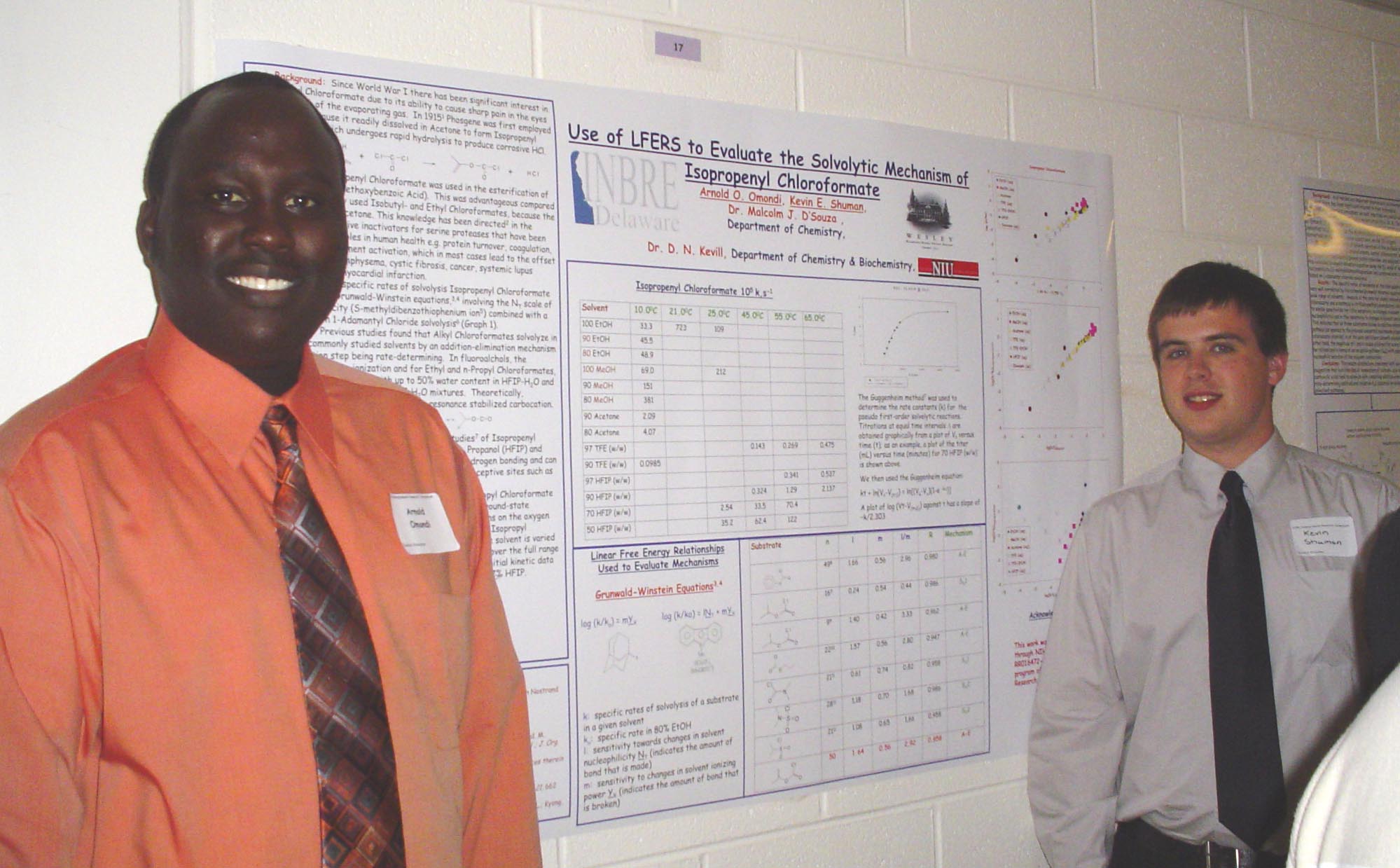 Use of LFERS to Evaluate the Solvolytic Mechanism of Isopropenyl Chloroformate 1Department of Chemistry, 2Department of Chemistry & Biochemistry, Northern Since World
War I there has been significant interest in Isopropenyl Chloroformate
due to its
ability to cause sharp pain in the eyes upon exposure of the
evaporating gas. In 1915 Phosgene was
first employed as a war
gas because it readily dissolved in Acetone to form Isopropenyl
Chloroformate
which undergoes rapid hydrolysis to produce corrosive HCl.
Recently Isopropenyl
Chloroformate was used in the esterification of pMOBA (peptidyl
p-methoxybenzoic acid). This use was
advantageous compared to the more commonly used Isobutyl- and Ethyl
Chloroformates,
because the former can produce acetone. This knowledge has been
directed in the
development of selective inactivators for serine proteases that have
been known
to play major roles in human health e.g. protein turnover, coagulation,
fibriolysis
and complement activation, which in most cases lead to the offset of
diseases
such as emphysema, cystic fibrosis, cancer, systemic lupus
erythematosus, and
myocardial infarction. Here we expand previous kinetic studies of
Isopropenyl Chloroformate
in predominantly aqueous alcohol solvents with varying solvent
nucleophilicity
and solvent ionizing power. This analysis includes 1,1,1,3,3,3-
Hexafluoro-2-
Propanol (HFIP) and 2,2,2-Trifluoroethanol (TFE) that exhibit strong
hydrogen
bonding and can dissolve a large number of biological molecules with
receptive
sites such as oxygen, double bonds or amine groups.
|
|
We have
been studying the formation of bromomandelates and the addition of
ethyl
acrylate to a cyclic bromomandelate. The
bromomandelation technique has been optimized in an easy, one-pot
synthesis
using (S)-mandelic acid, a
nitrogen-containing base, N-bromosuccinamide,
and an alkene in dry CH2Cl2.
Our most significant discovery was the high
selectivity of the base 2,6-lutidine towards adding the mandelate to
the
secondary position of the bromonium ion. We were also able to
successfully form
a carbon-carbon bond by adding ethyl acrylate to a cyclic
bromomandelate. This was done using a free
radical chain
reaction to abstract the bromine atom and add the ethyl acrylate by
reduction
of the double bond. After oxidation with
Dess-Martin Periodinane and lactonization with K2CO3,
we
were able to determine that this carbon-carbon bond formation proceeded
with
about 2:1 selectivity towards the trans diastereomer.
We would like to thank the Howard Hughes
Medical Institute for funding this project. |
|
Dynein light chain, the 8 kDa protein, is a crucial subunit in the motor protein complex of cytoplasmic dynein. The cytoplasmic dynein complex is used in transporting various cellular cargoes amongst cells via microtubules. The light chain subunits are directly responsible, but not limited solely, for binding the various cargoes onto the larger motor protein complex. Recent studies have shown the light chains abilities to regulate different biological processes by means of binding various proteins and enzymes. The studies conducted recently to discover such functions of the light chain can be attributed to the solution-state NMR technique used for the structural determination of the protein. The focus of this research is to perform solid-state NMR studies on the DLC8 in order to obtain results highly similar if not the same to that of the solution-state NMR study. The protocols for expression and purification of the unlabeled DLC8 protein have been successfully formulated. Construction of isotopically labeled samples of DLC8 are under way and necessary for solid-state NMR analysis. Funding for this project was from the Howard Hughes Medical Institute. |
|
The
scorpionates are an ever-growing class of versatile chemical compounds
that
have common applications in catalysis, enzyme modeling, metal
extraction, and
biomedicine. These tridentate ligands
are frequently complexed with metals, binding in such a fashion that
allows for
the control of the remaining coordination sites on the metal. Additionally, the pyrazol ring can be
modified with substituents, whose steric effects often have significant
impacts
on the chemistry of the ligand. The goal
of current research is to synthesize a scorpionate ligand with
ferrocene and
methyl groups attached at the 3 and 5 sites of the pyrazol,
respectively. With this ligand, an
examination of the
effects of the redox-active ferrocene groups can occur.
By successively oxidizing the ferrocene
groups, we can evaluate the chemical impact of an increasingly
positively
charged environment on the scorpionate ligand. Funding
from the Howard Hughes Medical
Institute and from the Department of Energy is gratefully acknowledged.
|
|
A New Method for the
Deprotection of Aryl Mesylates. The mesyl
group has been shown to be useful for protecting the hydroxyl group in
phenols. A key issue with any protecting
group is the development
of a method to remove it that is facile, efficient, and preserves
functionality
elsewhere in the molecule. A new method
developed in the Taber group uses heated diethylamine in a high
pressure
reaction vial to accomplish this goal. A
major advantage of this is that the diethylamine acts as both the
solvent and
the reagent in the reaction. Funding provided by the Howard Hughes
Medical
Institute. |
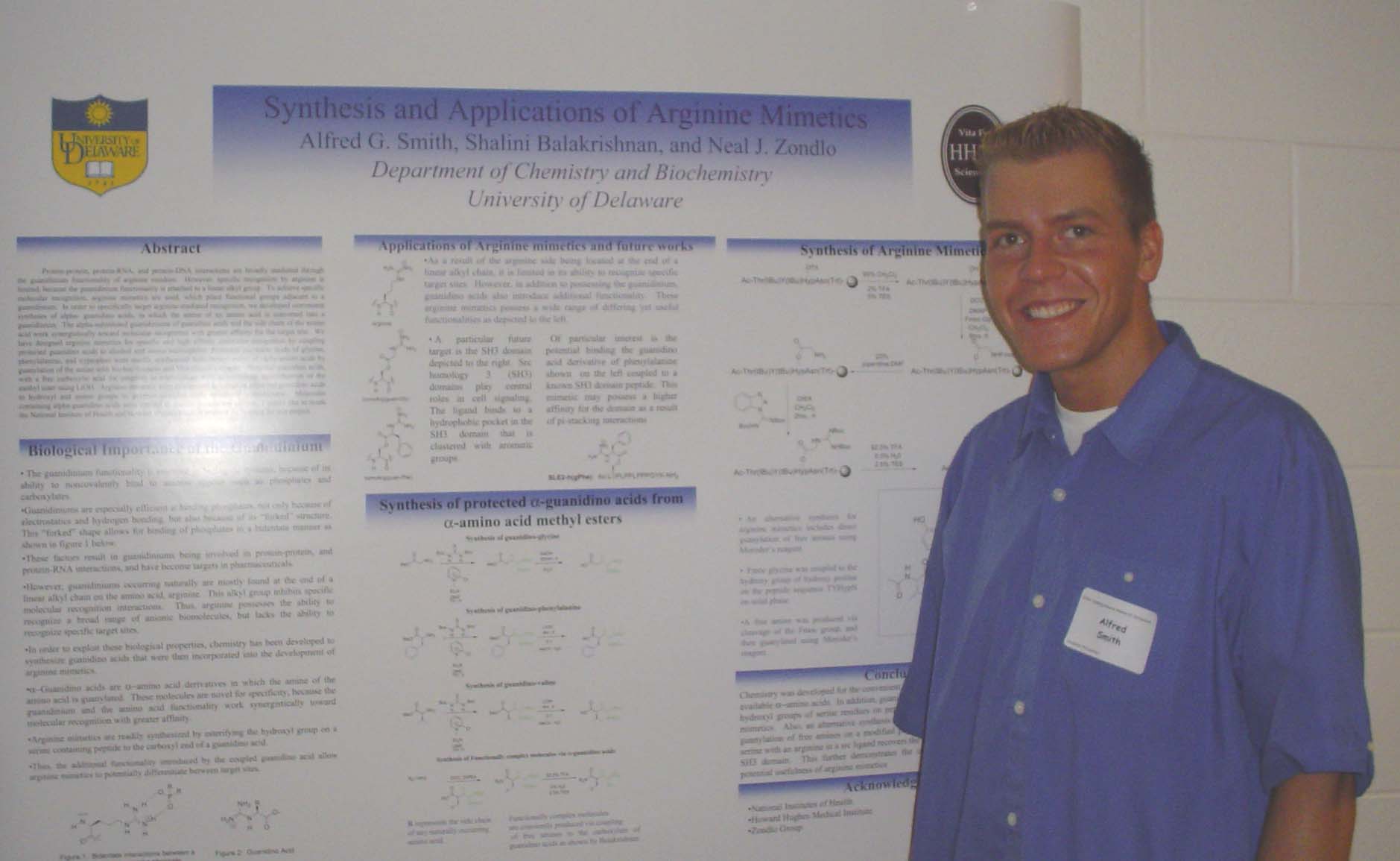 Synthesis and Applications of Arginine Mimetics Alfred Smith, Shalini Balakrishnan, and Neal Zondlo Department of Chemistry and Biochemistry Protein-protein,
protein-RNA, and protein-DNA interactions are broadly mediated through
the
guanidinium functionality of arginine residues. However,
specific recognition by arginine is limited,
because the
guanidinium functionality is attached to a linear alkyl group. To achieve specific molecular recognition,
arginine mimetics are used, which place functional groups adjacent to a
guanidinium. In order to specifically
target arginine-mediated recognition, we developed convenient syntheses
of
alpha- guanidino acids, in which the amine of an amino acid is
converted into a
guanidinium. The alpha-substituted
guanidiniums of guanidino acids and the side chain of the amino acid
work
synergistically toward molecular recognition with greater affinity for
the
target site. We have designed arginine
mimetics for specific and high affinity molecular recognition by
coupling
protected guanidino acids to alcohol and amine nucleophiles. Protected
guanidino acids of Gly, Phe, Val, and Leu were readily synthesized from
methyl
esters of alpha-amino acids by guanylation of the amine with
bis-boc-thiourea
and Mukaiyama’s reagent. Protected
guanidino acids, with a free carboxylic acid for coupling to
nucleophiles, were
generated by saponification of the methyl ester using LiOH. Arginine mimetics were synthesized by
coupling protected guanidino acids to hydroxyl and amino groups to
generate complex
alpha-substituted guanidiniums. Molecules
containing alpha-guanidino acids will be applied
to specific
protein and RNA recognition. Funding
from the National Institute of Health and Howard Hughes Medical
Institute
Undergraduate Science education Program. |
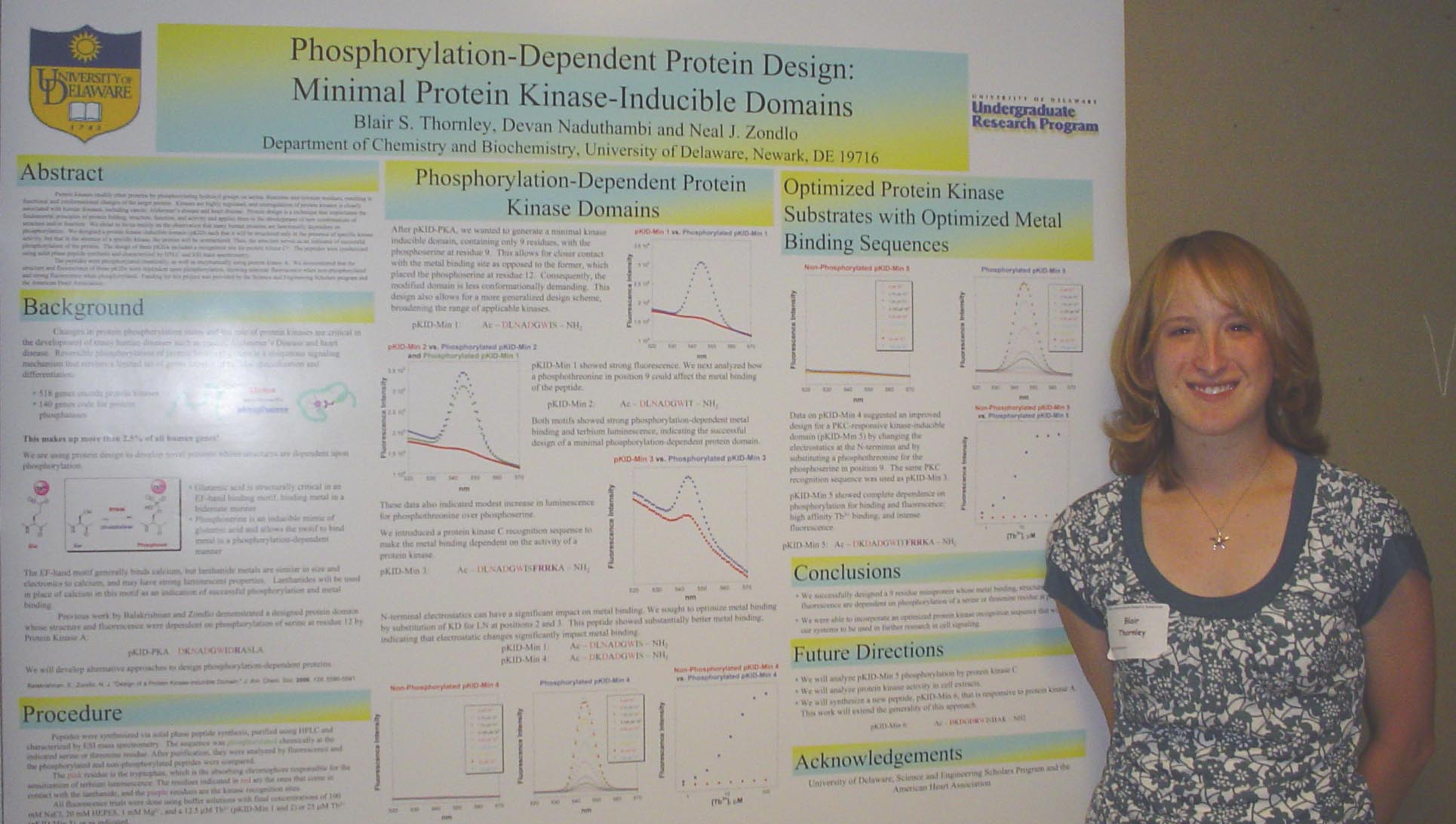 Phosphorylation-Dependent Protein Design: Minimal Protein Kinase-inducible Domains Blair S. Thornley and Neal J. Zondlo Department of Chemistry and Biochemistry Protein kinases modify
other proteins by phosphorylating hydroxyl groups on serine, threonine
and
tyrosine residues, resulting in functional and conformational changes
of the
target protein. Kinases are highly
regulated, and misregulation of protein kinases is closely associated
with
human diseases, including cancer, Alzheimer’s disease and heart disease. Protein design is a technique that implements
the fundamental principles of protein folding, structure, function, and
activity and applies them to the development of new combinations of
structure
and/or function. We chose to focus
mainly on the observation that many human proteins are functionally
dependent
on phosphorylation. We designed a
protein kinase-inducible domain (pKID) such that it will be structured
only in
the presence of specific kinase activity, but that in the absence of a
specific
kinase, the protein will be unstructured. Thus, the structure serves as
an
indicator of successful phosphorylation of the protein.
The design of these pKIDs included a recognition
site for protein kinase Ca. The
peptides were synthesized using solid phase
peptide synthesis and characterized by HPLC and ESI mass spectrometry. We demonstrated that the structure and
fluorescence of these pKIDs were dependent upon phosphorylation,
showing
minimal fluorescence when non-phosphorylated and strong fluorescence
when
phosphorylated. Funding for this project
was provided by the Science and Engineering Scholars program and the
American
Heart Association.
|
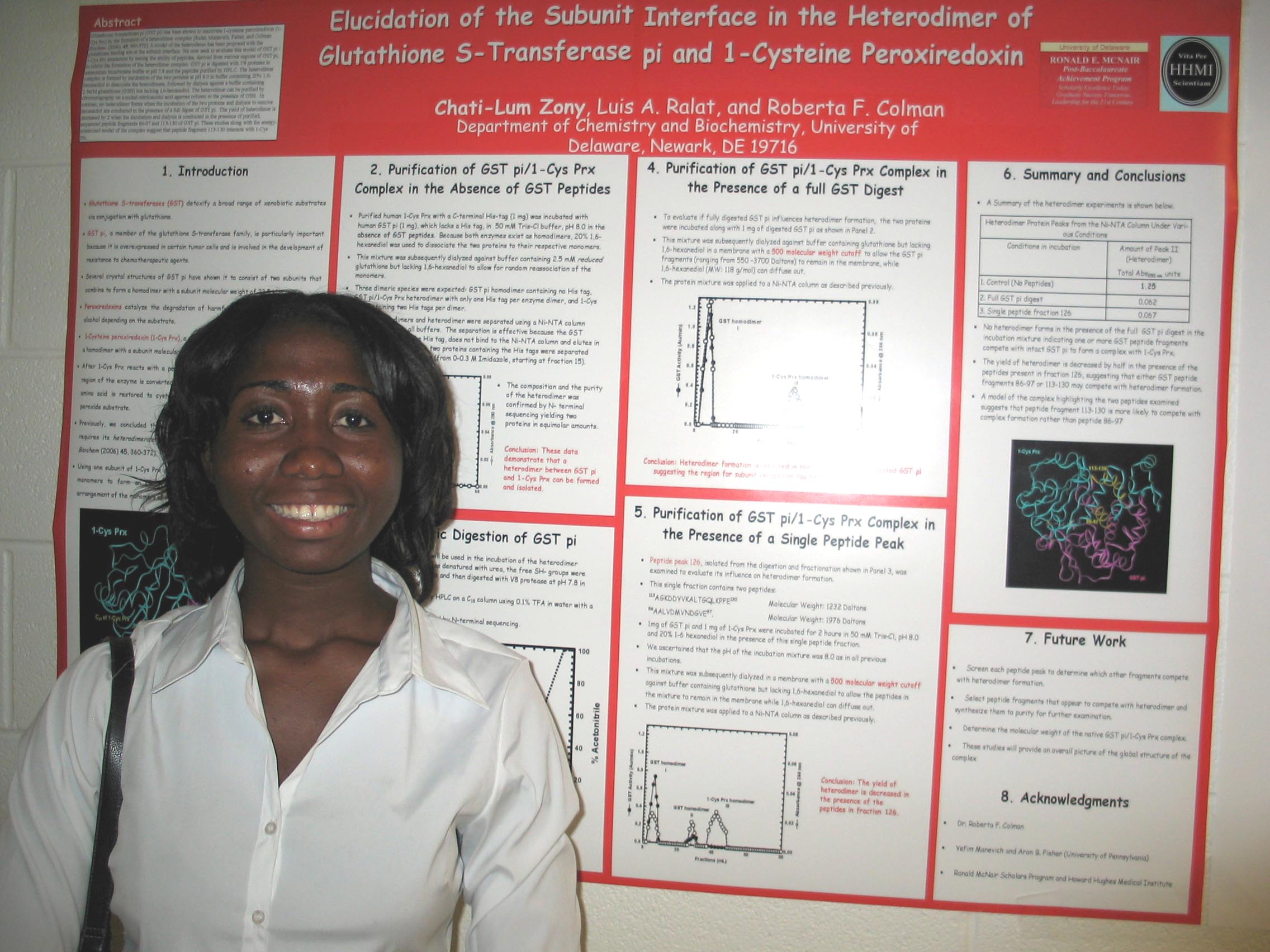 Elucidation of the Subunit Interface in the Heterodimer of Glutathione S-Transferase pi and 1-Cysteine Peroxiredoxin Chati Lum Zony, Luis Ralat, and Roberta F. Colman Department of Chemistry and Biochemistry |